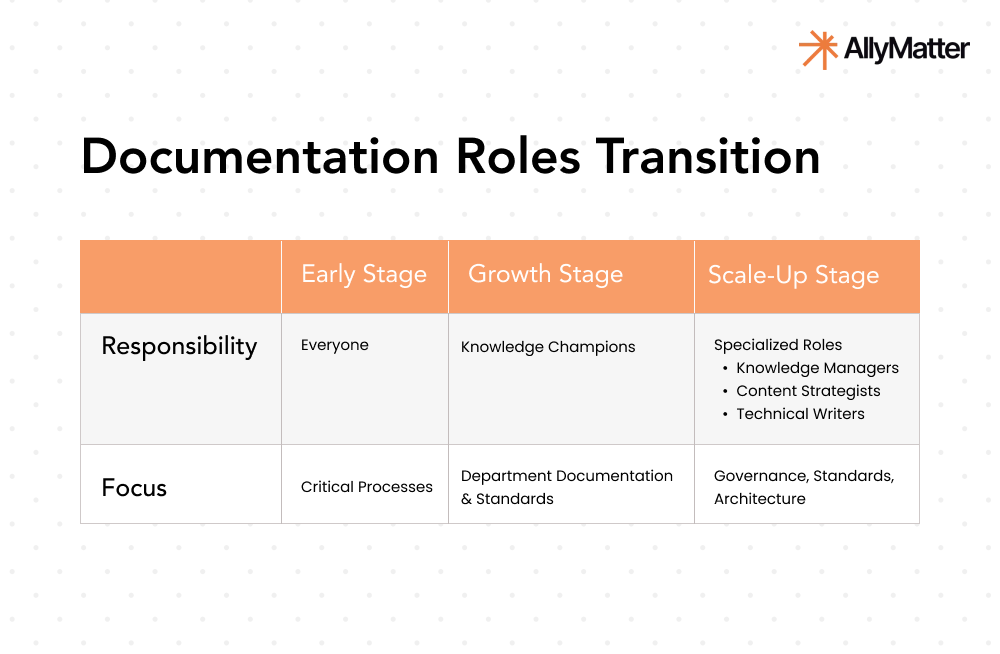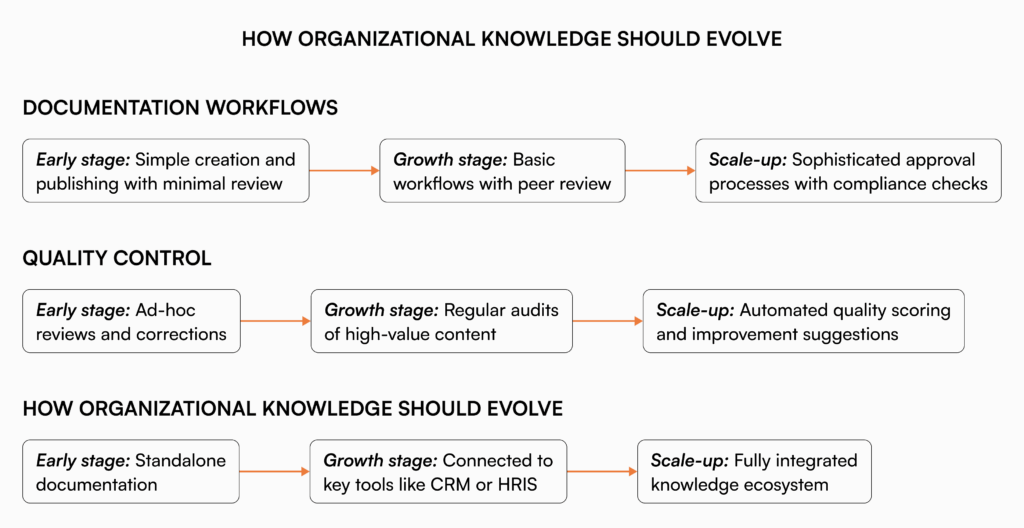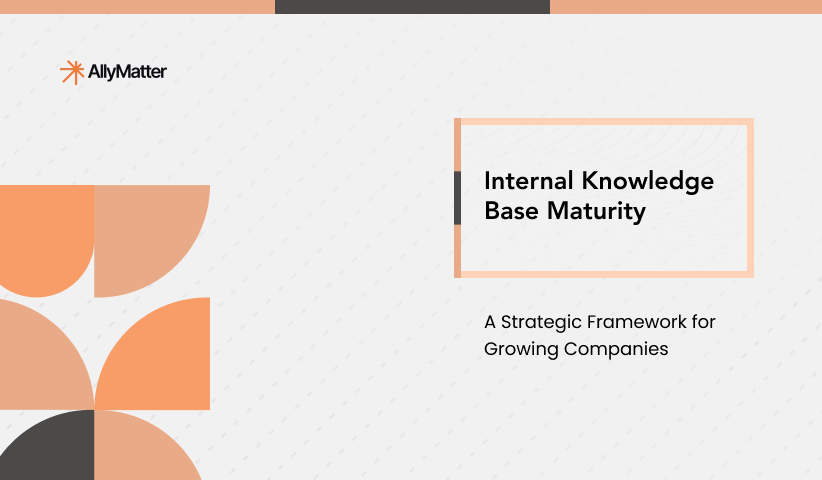Ever tried finding an important document in a sea of shared folders? Or spent hours explaining the same process to new team members? If your answer is yes, you’re not alone.
As companies grow from small, tight-knit teams to larger organizations, knowledge management often breaks down. What worked perfectly for five people becomes a chaotic mess at fifty—and nearly impossible at five hundred.
According to a McKinsey report, employees spend nearly 20% of their workweek searching for or gathering internal information. That’s a full day each week lost to knowledge inefficiency!
But scaling knowledge doesn’t have to be painful. Let’s explore how to build internal knowledge bases that grow seamlessly with your organization.
The growing pains of scaling knowledge
Remember when your company was small enough that everyone knew everything? Those days of shouting questions across the room or tapping a colleague on the shoulder are nostalgic but unsustainable.
As organizations grow, several challenges emerge:
- Information becomes siloed within teams.
- Institutional knowledge walks out the door with departing employees.
- New hires take longer to become productive.
- Decision-making slows as information becomes harder to find.
- Duplicate work happens because solutions aren’t properly documented.
Consider what happened at Dropbox as they scaled. In their early days, the team relied on casual knowledge sharing and Google Docs. But as they grew to hundreds of employees across multiple offices, this approach collapsed. Eventually, they had to build their own internal knowledge management system called Dropbox Paper, partly because their existing solutions couldn’t scale with their growth.
How documentation roles evolve with growth
In startups, everyone wears multiple hats—including the “documentation person” hat. The founder might write the initial product guide, while an engineer documents the codebase between coding sessions.
This works until it doesn’t.
As your company grows, documentation roles need to evolve too:

Early stage (5-20 employees)
At this stage, documentation is everyone’s responsibility, though certain team members might naturally take more initiative. The focus is on documenting critical processes and decisions, even if the system is basic.
Growth stage (20-100 employees)
Now you need dedicated “knowledge champions” within each team. These individuals take ownership of their department’s documentation while following company-wide standards. They might spend 10-20% of their time on knowledge management.
Scale-up stage (100-500+ employees)
At this point, you need specialized roles: knowledge managers, content strategists, and technical writers. These professionals create governance frameworks, establish quality standards, and build scalable information architecture.
Picture this: A software company’s CTO had been the documentation guru for years, creating extensive wiki pages for every technical decision. As they grew past 150 employees, this became unsustainable. He was spending half his time maintaining documentation instead of focusing on strategic work.
The solution? They created a dedicated Documentation Team with representatives from each department, led by a Knowledge Manager who reported directly to the COO. This structural change allowed their knowledge base to scale without overwhelming the executive team.
Building a knowledge base that scales
Structure that grows with you
The foundation of a scalable knowledge base is flexible information architecture. Instead of rigid folder structures, consider these approaches:
- Topic-based organization: Group content by subject matter, not department.
- Tagging systems: Apply multiple metadata tags to make content discoverable through different paths.
- Modular content: Break information into reusable components.
For example, a global consulting firm switched from department-based to topic-based organization. It resulted in considerable reduction in information duplication and improved cross-functional collaboration scores in employee surveys.
Access and governance at scale
In small teams, everyone can access everything. At scale, this becomes impractical and potentially risky.
Implement graduated access controls:
- Basic company information accessible to all
- Department-specific information visible within teams
- Sensitive information restricted to relevant roles
Each growth stage requires more sophisticated permissions:
- Early stage: Simple public/private settings
- Growth stage: Team and role-based permissions
- Scale-up: Granular access controls with approval workflows
Keeping knowledge fresh as you grow
The half-life of knowledge is shrinking. IBM estimates the half-life of professional skills is just five years—and even less for technical skills—meaning what you learn today will lose roughly half its value within five years..
As your organization scales, implement these practices:
- Assign clear ownership for each knowledge area.
- Set automatic review dates based on content type (processes every quarter, policies annually).
- Use analytics to identify outdated content (low usage, high bounce rates).
- Create feedback loops so users can flag information that needs updating.
How processes evolve as you scale
Knowledge management processes that work for 10 people will fail at 100. This image explains how to evolve them successfully.

For example, a healthcare technology company started with a simple Confluence space. As they grew past 200 employees, they implemented structured workflows that automatically routed new content through compliance review when it contained regulated information. This evolution allowed them to scale their knowledge base while maintaining regulatory compliance.
The cost of getting it wrong
Organizations that delay investing in scalable knowledge management face significant costs that affect the entire business:
- Reduced productivity as employees waste hours searching for information or recreating existing solutions
- Diminished customer satisfaction when support teams can’t quickly access accurate product information
- Increased error rates when employees work with outdated or incorrect documentation
- Slower innovation cycles because insights and learnings aren’t effectively shared across teams
Beyond these business impacts, there are human costs: frustrated employees who can’t find what they need, longer working hours spent recreating existing knowledge, and missed opportunities for collaboration.
For example, a financial services firm discovered that their fragmented knowledge approach was adding three weeks to their new hire onboarding process. By implementing a structured knowledge base with role-specific learning paths, they reduced onboarding time significantly and improved new hire satisfaction scores.
Future-proofing your knowledge base
As your organization continues to grow, leverage these emerging approaches:
- AI-powered search and recommendations: Surface relevant information proactively.
- Knowledge graphs: Map relationships between people, content, and concepts.
- Intelligent content lifecycle management: Automatically identify content for review based on usage patterns and changes in related documentation.
The time to start is now
Whether you’re a 5-person startup or a 500-person company, the principles remain the same: build knowledge systems that can grow with you.
Start with clear ownership, consistent structure, and regular maintenance. As you grow, evolve your processes, tools, and roles to match your organization’s increasing complexity.
Remember, an effective knowledge base isn’t just a repository of information—it’s a dynamic system that captures, organizes, and distributes your organization’s collective intelligence. When done right, it becomes one of your most valuable competitive advantages.
The question isn’t whether you can afford to invest in scalable knowledge management. It’s whether you can afford not to.
Ready to scale knowledge management to the next level? Let’s talk.


